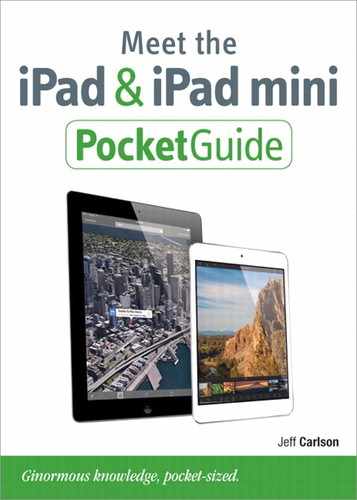Multi-Touch Gestures
You probably noticed that when you opened the iPad’s box, no stylus fell out. Until fairly recently, most tablet computers and handhelds required that you use a plastic pencil to do anything. The iPad, instead, is designed for your fingers. You interact with the software on the screen by touching, tapping, swiping, and performing other Multi-Touch gestures. Many controls are intuitive: Tap the Edit button in Contacts, for example, to edit a person’s information. Other motions may not be obvious at first, but they quickly become natural.
Tap
As you’ve no doubt discovered, the most obvious action is to point at an area of the screen, like a button or other control, and lightly tap with one finger. Sometimes, you’ll want to double-tap the screen, such as when you want to zoom in on a section of a Web page in Safari.
Tip
When you encounter an On/Off switch, you can slide the switch if you want, or simply tap it to change its state.
Touch and hold
Instead of quickly tapping and lifting your finger from the screen, there are times when you want to touch the screen and maintain contact to elicit an action (for example, see “Work with Text,” ahead).
Drag
Touch and hold a point on the screen, then move your finger across the glass. Drag a Web page in Safari from bottom to top to scroll as you read.
Tip
Don’t worry if a finger touches a screen edge when you’re holding the iPad Air or iPad mini; the software automatically ignores that contact.
Flick and swipe
A flick (yes, that’s Apple’s official name for it) is like a drag, but faster. On a Web page, touch the screen and flick your finger to “throw” the page in any direction. The software simulates the physics of the motion and slows the scrolling page until it comes to a stop, based on the velocity of the flick.
A swipe is similar to a flick, but you drag something (usually horizontally) a bit more slowly. You swipe a photo from right to left to advance to the next picture, for instance.
Note
The iPad’s screen responds to the electricity in your fingers, not to pressure. Pressing harder on the display doesn’t improve its response.
Pinch
When you want to zoom in or out on an item, such as a map, a photo, or a Web page, touch two fingers to the screen and pinch them together (to zoom out) or spread them apart (to zoom in).
Rotate
Press two fingers to the screen and rotate them in a circle to rotate something, such as a photo in the Photos app.
Shake
Yes, that’s right, give the iPad a good shake. The accelerometer recognizes the motion as an intentional vibration, and software that’s been written to handle the gesture can act on it. For example, when you’re typing in the Notes app and make a mistake, shake the iPad to bring up a dialog that gives you the option to undo the last action. I’ve found that shaking front to back, not side to side, seems to be more responsive.
Use two hands
The iPad’s entire screen is filled with sensors, so take advantage of the large display area and use both hands. One obvious application is the keyboard that appears when you’re entering text; since it’s nearly full size, you can type as you would on a physical keyboard.
For another example, look to Apple’s Keynote app: Touch and hold a slide with the finger of one hand, and then use your other hand to tap other slides to select them all in a group. Numerous games and other apps also accept two-handed input.
